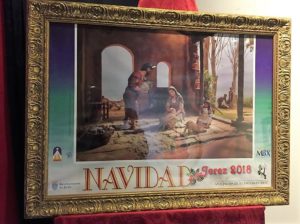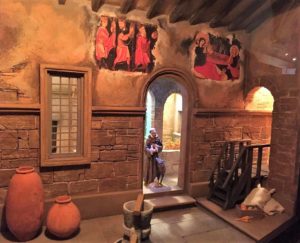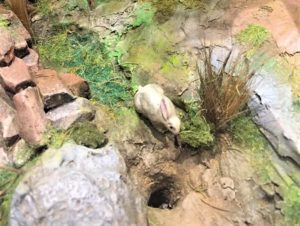 …is Belen in Spanish. This also describes those models of the nativity and associated bible stories which I remember from childhood as being quite common in Britain too. As we have become more secular these have become rarer and public nativity scenes, once often found outside churches, seem to have disappeared entirely, mainly because Britain is no longer a regular church-going nation. Not so in Jerez, where there are two at present. The one in Plaza Ascuncion is made out of lights, but the one in the Alameda Christina (see above left), is more traditional, it’s life-sized and looks, to my untutored eye, rather like a stable in Nazareth might indeed have looked at the time.
…is Belen in Spanish. This also describes those models of the nativity and associated bible stories which I remember from childhood as being quite common in Britain too. As we have become more secular these have become rarer and public nativity scenes, once often found outside churches, seem to have disappeared entirely, mainly because Britain is no longer a regular church-going nation. Not so in Jerez, where there are two at present. The one in Plaza Ascuncion is made out of lights, but the one in the Alameda Christina (see above left), is more traditional, it’s life-sized and looks, to my untutored eye, rather like a stable in Nazareth might indeed have looked at the time.
Belen inspires Belenista Societies across Andalucia, maybe across Spain, I don’t know. Each year for Christmas, these societies create miniature Nativities and in Jerez there are several exhibitions of them right now. We went to see the largest in the cloisters of Santo Domingo monastery by the Asociacion de Belenistas de Jerez.
It’s not the first time we have been to see this regular event and it was clear that, for many of the local townspeople who were also there that day, it wasn’t the first visit either. We saw three generations in some groups, who we assumed were families. I suspect that the young children were being brought there by parents who had  themselves been taken there by their parents, now the grandparents who accompanied them. It was quite crowded, but in a good way.
themselves been taken there by their parents, now the grandparents who accompanied them. It was quite crowded, but in a good way.
The nativities are back-lit Dioramas and they show more than just the traditional stable scene. There was one dramatic red-lit representation of the Slaughter of the Innocents and several Flights into Egypt, through perfectly depicted miniature woodlands. The more traditional ‘stable’ scenes all used perspective, views and sight lines into other rooms, or to the outside which reminded me of detailed paintings of Dutch interiors of the seventeenth and eighteenth centuries, with their receding tiles and fine detail.
One favourite was a chapel scene, the nativity being present in a fresco painting on the chapel wall, in byzantine style, exposed as if discovered by later restorations, as was another fresco showing the three kings. The holy figure in the scene seemed to be Saint Francis, accompanied by dog, doves and other animals (and a very large turkey which could be seen through the window only from a certain angle). In this, as in all the scenes, the viewers (and especially the children) were engaged by the tiny details. A white hare about to disappear down a hole in the ground, a cat eyeing up the catch of fish on display at a fisherman’s stall.  Some were kitsch, but fun, others were very fine, like the sculpted piece of bark made into a dramatic shelter for the holy family. It was good to see them all.
Some were kitsch, but fun, others were very fine, like the sculpted piece of bark made into a dramatic shelter for the holy family. It was good to see them all.
One event which Jerez doesn’t have is the increasingly popular Belen Vivante or Living Bethlehem. During the weekend there were no fewer than six taking place in towns in the area, from the well-known and established version in Arcos de la Frontera to similar, smaller events in other town squares. There are, I fear, just too many people in Jerez for the zambombas already, the residents might rebel at even more.
For more articles on advent in Jerez try Saturday Night Christmas Dancing in the Streets Zambomba! Advent


 RSS – Posts
RSS – Posts